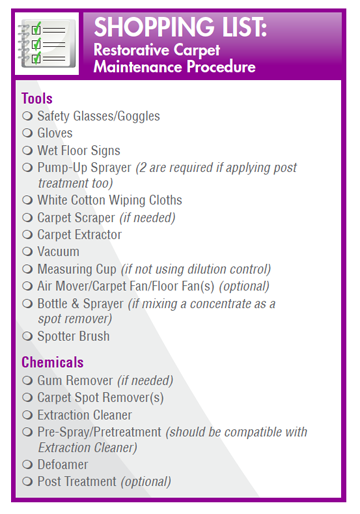New technologies have made soil extraction the preferred method for both interim carpet maintenance and restorative cleaning. There are three basic types of extractors: truck-mounted units with long hoses and a carpet wand or tool; portable tank-style or “box” units with hoses and a wand or tool; and portable, self-contained units.
 An extractor sprays cleaning solution into the carpet. Normally the solution is worked in with a rotating brush to dislodge dirt. Then dirt and solution are lifted out through a vacuum head. This method is very effective and leaves little residue. An operator with a modern extractor can clean up to 18,500 square feet per hour in the low-moisture mode, or up to 8,000 square feet per hour in the restoration mode.
An extractor sprays cleaning solution into the carpet. Normally the solution is worked in with a rotating brush to dislodge dirt. Then dirt and solution are lifted out through a vacuum head. This method is very effective and leaves little residue. An operator with a modern extractor can clean up to 18,500 square feet per hour in the low-moisture mode, or up to 8,000 square feet per hour in the restoration mode.
Deep Extraction
Even when carpets become heavily contaminated with soils, they can usually be restored to good condition with deep extraction. Deep extraction may also improve the general appearance and delay replacement of damaged carpet. This method is very similar to surface extraction, but the equipment is used at a slower cleaning rate.
For all interim or restorative methods, you should first vacuum the area and treat spots with spot removers. For best results, traffic lanes and heavily soiled areas should be treated with a pre-spray or pretreatment to loosen and emulsify tough soils and improve the effectiveness of the cleaning process.
WAXIE HINT: Here’s a nice way to recycle, make good use of remaining cleaning solution and keep your extractors & scrubbers looking new!
Many automatic scrubbers and carpet extractors have a clean solution tank sight tube or drain hose. When you've drained the dirty solution out of the machine, there is always sludge, dirt and residue left behind in the recovery tank. Take the vac hose off the squeegee stand pipe or vac shoe, turn on the vac, open up the clean solution sight tube or drain hose and suck the remaining clean solution into the recovery tank. This gives the dirty tank a final rinse and after draining it one more time, leaves the tank clean and fragrant for storage and the next use. No need for water hoses or an extra trip to the water source.
Your WAXIE Sanitary Maintenance Consultant can provide additional information about the techniques discussed here and make product and equipment recommendations for your specific requirements. Contact us today (800) 995-4466.

